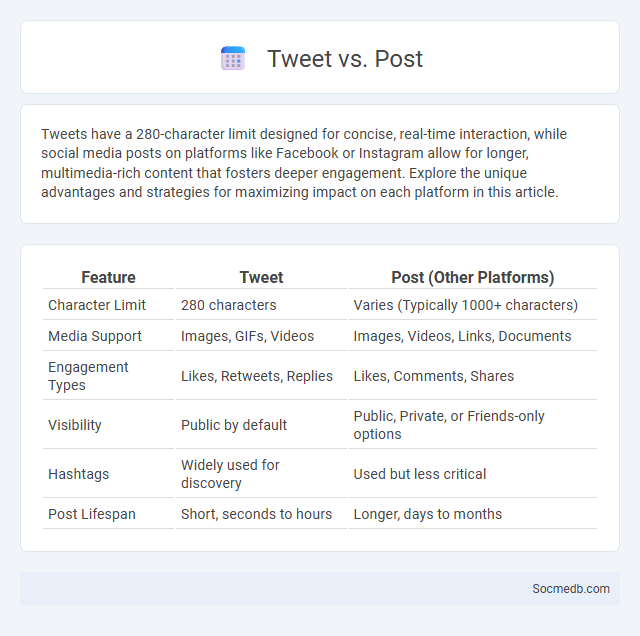
Photo illustration: Tweet vs Post
Tweets have a 280-character limit designed for concise, real-time interaction, while social media posts on platforms like Facebook or Instagram allow for longer, multimedia-rich content that fosters deeper engagement. Explore the unique advantages and strategies for maximizing impact on each platform in this article.
Table of Comparison
| Feature | Tweet | Post (Other Platforms) |
|---|---|---|
| Character Limit | 280 characters | Varies (Typically 1000+ characters) |
| Media Support | Images, GIFs, Videos | Images, Videos, Links, Documents |
| Engagement Types | Likes, Retweets, Replies | Likes, Comments, Shares |
| Visibility | Public by default | Public, Private, or Friends-only options |
| Hashtags | Widely used for discovery | Used but less critical |
| Post Lifespan | Short, seconds to hours | Longer, days to months |
Introduction to Social Media Terminologies
Social media terminologies encompass key concepts such as engagement, reach, impressions, and algorithms that dictate content visibility. Understanding terms like hashtags, influencers, and user-generated content is essential for effective digital communication and marketing strategies. Mastery of these concepts enables targeted audience interactions and optimized platform use.
Defining Tweets, Posts, and Trending Topics
Tweets are concise messages limited to 280 characters on Twitter, allowing users to share thoughts, news, and multimedia instantly. Posts refer broadly to any content uploaded on social media platforms like Facebook, Instagram, or LinkedIn, including text, images, videos, and links designed to engage your audience. Trending topics highlight the most discussed subjects across social networks in real-time, reflecting current events, popular hashtags, and viral content shaping online conversations.
Key Differences: Tweet vs Post
Tweets are limited to 280 characters, encouraging concise and real-time updates, while social media posts on platforms like Facebook and Instagram allow for longer text along with multimedia integration. Tweets emphasize hashtags and mentions to increase visibility and engagement quickly, whereas posts can incorporate richer content such as photos, videos, and detailed descriptions. The user interaction on Twitter is fast-paced with retweets and likes, contrasting with the more varied reaction options and commenting styles found in other social media posts.
How Trending Topics Emerge
Trending topics emerge from a rapid and widespread increase in social media engagement around specific events, hashtags, or keywords. When Your audience starts sharing, commenting, and interacting with related content simultaneously, algorithms identify these spikes in activity and amplify visibility across platforms. This process is driven by viral sharing dynamics, influencer participation, and news cycles that collectively fuel the prominence of trending subjects.
Platforms Where Tweets, Posts, and Trends Matter
Twitter remains a leading platform where real-time tweets shape global conversations and trending hashtags drive mass engagement. Facebook dominates with extensive user demographics, enabling dynamic post-sharing, community building, and targeted advertising. Instagram thrives on visual storytelling, where posts and trending reels influence lifestyle, fashion, and brand visibility across diverse audiences.
Impact on User Engagement
Social media platforms significantly increase user engagement by providing personalized content and interactive features such as likes, comments, and shares that encourage active participation. Algorithms optimize content delivery based on user behavior, boosting the time you spend on these platforms and deepening your connection with brands and communities. Enhanced user engagement outcomes include higher conversion rates, improved brand loyalty, and greater content virality.
Content Virality: Tweet vs Post in Trends
Content virality on social media varies significantly between tweets and posts due to platform algorithms and user engagement patterns. Tweets tend to spread rapidly because of retweets and hashtag trends, amplifying reach within short time frames, whereas posts on platforms like Facebook or Instagram often rely on shares and comments for extended visibility. Understanding these mechanisms allows you to tailor your content strategy effectively for maximum viral impact across different social networks.
Metrics for Measuring Popularity
Social media popularity is effectively measured using metrics such as engagement rate, follower growth, and reach. Engagement rate, including likes, comments, and shares, reflects the level of interaction with your content. Tracking these key metrics enables you to optimize your social media strategy for maximum visibility and influence.
Best Practices for Leveraging Trending Topics
Leveraging trending topics on social media involves timely engagement by sharing relevant content that resonates with your target audience. You should monitor trends closely using tools like Google Trends and Twitter's Trending section to align your posts with current conversations. Craft your messages to add value or unique insights, ensuring they enhance your brand's visibility and foster genuine interaction.
Conclusion: Strategic Use of Tweets, Posts, and Trends
Strategic use of tweets, posts, and trends on social media can significantly boost Your brand visibility and engagement by targeting the right audience with timely content. Leveraging trending hashtags and interactive features enhances reach and fosters genuine connections with followers. Consistently analyzing performance data helps refine strategies to maximize impact and achieve marketing goals.
 socmedb.com
socmedb.com